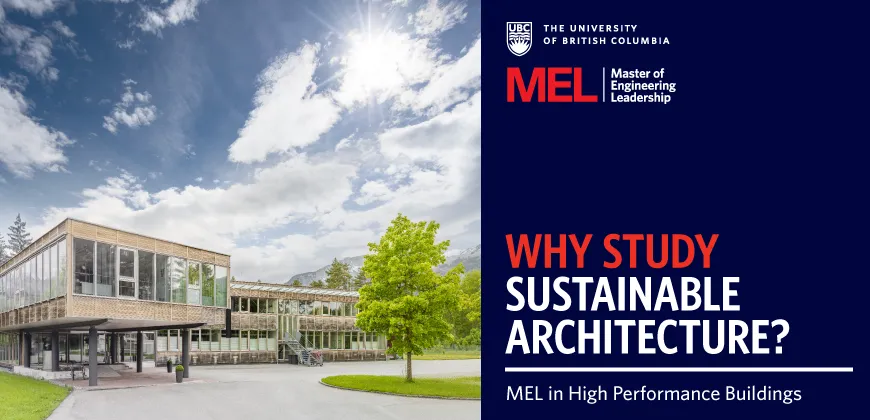Building Engineers Bring Resilience to Building Design

More frequent and intense storms, increasing droughts and flooding, and record-high temperatures in urban environments are now the new normal. The current and future impacts of climate change are transforming the way we design buildings.
Building engineers are expanding their scope of practice to bring resilience into their designs.
They are pushing the innovation envelope by designing buildings that can withstand – and continue to maintain their function – during extreme weather events and natural disasters like earthquakes.
Building systems engineers take a holistic, resilient approach
To address these challenges, building engineers are adopting new approaches based on resilient or regenerative design. “Regenerative design starts from the understanding that a building is much more than just a building,” says Michel Labrie, an instructor in UBC’s Master of Engineering Leadership in High Performance Buildings and founding principal of Local Practice Architecture & Design.
“It’s a design approach that asks practitioners to take a few steps back and look at the buildings they are developing within the context of the grand challenges we are facing face today, from climate change and sustainability to the future of cities and the future of work.”
Resilient design is a holistic approach that situates the building within a much larger context than the immediate site location. It might involve choosing locations close to transportation networks and nodes to reduce building users’ reliance on vehicles.
Building for resilience involves stepping back to consider the entire life-cycle of a structure.
Take material choice, for example. Building engineers are increasingly sourcing local materials (which supports nearby communities and results in lower emissions to transport materials). They are also choosing materials for specific properties of durability and low embodied carbon values. Reusing existing materials is another strategy for reducing carbon (and costs). Energy efficiency is achieved by starting with passive design principles, including the placement of the building on the site, choosing materials for their thermal mass properties, incorporating natural airflow to reduce the need for mechanical ventilation, using shading devices, incorporating green roofs and walls, and carefully considering the placement of windows.
Once passive design elements have been incorporated, building engineers will prioritize energy-efficient HVAC heating and cooling systems.
On-site renewable energy systems like solar panels are also an important consideration in ensuring building resiliency in the case of widespread power outages as a result of storms or other disasters.
Building engineers interested in resiliency also need to be well versed in digital technology.
Smart thermostats and controls that are integrated in building management systems enable building owners monitor energy use and optimize systems.
Building systems engineers needed to lead transformation
A new kind of building engineer is needed to guide the transition to a more sustainable building industry.
People with strong technical expertise in structural and mechanical engineering are needed to develop, implement and scale-up the innovative solutions that will allow for more resilient buildings. But this alone is not enough. Given the complexity of the challenge facing us, the building and construction industry needs building engineers who are visionary leaders, strong communicators and innovative problem-solvers.
This has opened up exciting opportunities for professionals who combine technical engineering expertise with powerful people skills.
These leaders have the communication and team-building skills to bring together integrated design teams of engineers and architects to solve complex technical problems and who can work with stakeholders from government, communities and industry to find common ground and sustainable paths forward. Similarly, there’s a pressing need for people who understand policy and its role in shifting building and construction practices so they are better aligned with sustainability goals.
World-class training in building engineering
The comprehensive curriculum for the UBC MEL in High Performance Buildings was designed for professionals with at least three years of industry experience who want to gain new technical and business skills to support their transition to roles with greater levels of responsibility and oversight.
The technical component curriculum brings together architecture courses in green building design and engineering courses in energy modeling and design.
Coursework foregrounds practical examples, projects and case studies, including two capstone projects. In the first capstone project, students develop a plan to retrofit an existing building and in the second they develop an energy systems design for a new building. Students complete their final capstone projects as members of an integrated design team made up of a diverse mix of architects and building engineers. One group of students recently developed a design for a school that prioritized resiliency.
“The challenges we're designing for are considering future scenarios, solving issues that the school might have to deal in the future,” explains group member Gabriela Mercado.
“Some of them we've already experienced a little, like the heat dome in 2021, but others are not very evident but are equally important to be prepared for and to provide the school with the infrastructure to face them, such as flooding, drought periods and other hazards caused by climate change.” The students entered their design into the renowned U.S. Department of Energy Solar Decathlon Design Challenge and were invited to advance to the finals based on their innovative design. Another group of students designed a multipurpose building for the Department of Defence in Nunavut, the world’s most northerly permanent inhabited location. The group came up with a future-proof design that could withstand extreme and changing climate conditions in a unique location while also reflecting local culture and context.
The program’s technical courses and capstone projects are complemented by courses on leadership, data analytics, strategy and sustainability, ensuring that graduates have the business knowledge needed to advance into leadership positions.
Building engineering is a soaring industry
Graduates of the MEL in High Performance Building are entering a local industry experiencing significant growth. A report from the Vancouver Economic Commission showed sectoral growth of 187% from 2010-2020. The report claims that the green building sector is the “largest employer in Vancouver’s green economy” and it paints a positive picture for the future.
“Widely regarded as a global centre of excellence in green buildings, Vancouver’s green buildings design and construction is the second-largest sector under the green economy umbrella, driven by progressive policies and international demand for local expertise," the VEC writes.
The policies referenced in the study include those at the municipal, provincial and federal levels to reduce the emissions impact of the building industry. These include Vancouver’s Zero Emissions Buildings Plan and the province’s CleanBC plan, as well as other initiatives to promote mass timber and more sustainable construction methods compared to traditional approaches. The convergence of economic opportunity with a broader policy environment that supports green practices makes Vancouver a uniquely exciting place to pursue graduate studies focused on resilient building engineering practices.
A master’s degree in building engineering that brings it all together
Professional master’s degrees like UBC’s Master of Engineering Leadership in High Performance Buildings provide forward-thinking individuals with the skills needed to make a positive impact in the building and construction industry. This is thanks to:
- An interdisciplinary curriculum that combines technical and business knowledge
- Opportunities to connect with industry leaders through course projects, including two capstone courses
- Industry networking opportunities throughout the year
- Learning alongside other professionals like yourself, from all over the world, who bring impressive experience to their studies
- The potential to participate in UBC programs like Sustainability Scholars and Creative Destruction Lab
“The MEL in High Performance Buildings helps students acquire the technical skills they need to design and build high performance buildings,” says Labrie.
“But it goes beyond that. This course in regenerative design – and others in the program – complement that technical understanding with perspectives on sustainability that encompass a range of social, ecological and reconciliation elements. The result is the potential for powerful transformation and career advancement, enabling our graduates to make new connections and work for lasting change as they pivot into new areas of practice and enter new fields of specialization.”
Alumni of the MEL in High Performance Buildings are well prepared to advance in their careers and make a tangible impact in the building industry.



